|
|
|
|
Products mentioned in this Article
--None--
|
|
|
|
|
|
|
|
|
 |
|
|
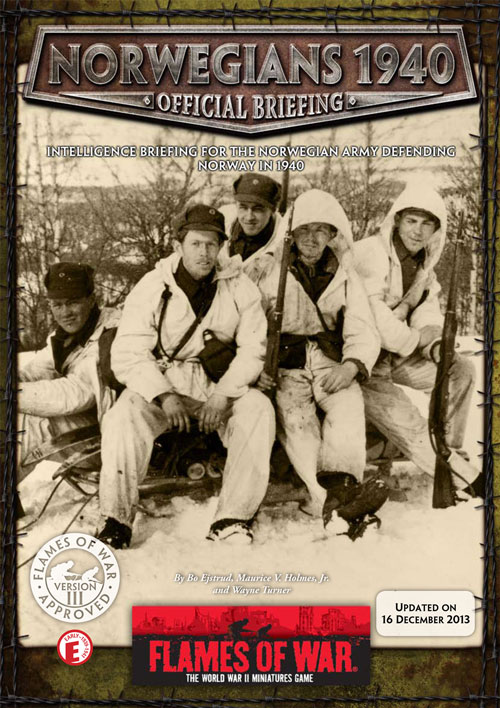 |
Norwegians 1940:
Intelligence Briefing For The Norwegian Army Defending Norway In 1940
with Bo Ejstrud, Maurice V. Holmes, Jr. and Wayne Turner
The Norwegians relied on their neutrality to keep them out of war. The government was convinced that British control of the seas would prevent Germany from invading Norway. They were further convinced that Britain would not invade at all. However, the convergence of three disparate elements would work to undermine their hopes.
The first was Swedish iron ore, which was a war necessity for Germany, and the transporting of which the Allies were working to intercept or halt altogether. Shipped from the Norwegian port of Narvik, iron ore could make its way on German transport ships down the coastline of neutral Norway, free from interference from the British navy. The second was the introduction of Vidkun Quisling to Adolf Hitler on 14 December 1939.
|
Quisling, former Norwegian Minister of Defence
indicated to Hitler how useful it would be for Germany to have a
pro-German government in power. It appears that in 1940 he also informed
Hitler that the British had approached the Norwegian government with a
proposal to allow allied forces on Norwegian soil. Hitler was determined
that this would not be permitted because of the threat to the shipment
of iron ore.
The third was the Altmark incident, which occurred
on 16 February 1940 in which British sailors from the destroyer HMS
Cossack boarded the German supply ship Altmark and freed the British
sailors that were captive on the ship. The Altmark was the supply ship
for the Pocket-Battleship Graf Spee, which had been raiding in the
Atlantic. This liberation took place in Norwegian waters and was
perceived by Hitler as a violation of Norway’s neutrality by the Allies.
|
On 1 March 1940 Adolf Hitler issued a directive for the invasion of Norway; code name Weserubung.
The German Plan
The German plans
called for a series of coup de main attacks at various cities in Norway.
There would be naval landings at Narvik, Trondheim, Bergen and
Kristiansand. Stavanger would be captured by paratrooper assault, while
Olso would be taken by sea assault and airdrop.
The Norwegain Defence and Forces
Like
most European armies the Norwegians relied on conscription, but had an
extremely short training period for the troops. Around 1930 an infantry
soldier was trained for a mere 48 days, although the period was
increased during the 1930s, reaching 84 days before the war. They lacked
a corps of NCOs, the only full-time professional military personnel
being the officers. |
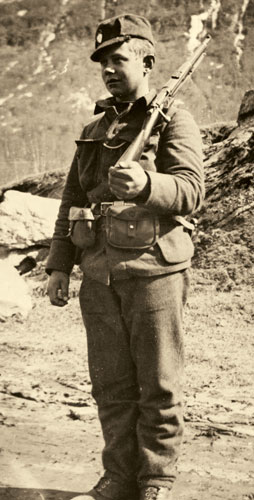 |
The Norwegian Army was organized in six Divisions. This may sound like a
substantial force for a small country, but a ‘Division’ of the
Norwegian Army was an area command, mainly with administrative and
training functions. In fact each division fielded a Brigade, each with
four infantry battalions, a regiment of field artillery (Divisions 1, 2
and 5) or a battalion of mountain artillery (Divisions 3, 4 and 6), and
support units. Added to this were local defence units organised in
independent battalions, and the forts within the Division’s area. Three
Divisions (1, 2 and 5) also had a Cavalry Regiment.
In total the armed forces of Norway could field
up to 90,000 men when fully mobilized. On the morning of the German
attack the Norwegian Army had 19,000 men under arms. The government
decided on a partial mobilisation. Much like Poland in 1939, the
Norwegian government felt that full mobilisation of the armed forces
would encourage Germany to invade Norway. The partial mobilisation may
have been a sound decision, avoiding the calling up of the last, most
unusable reserves. Unfortunately, the plans for partial mobilisation
also called for the notifications to conducted through the mail service.
The General Command refused to change this part of the plan, causing
much confusion and delay in the mobilising forces during the early days
of the crisis.
|
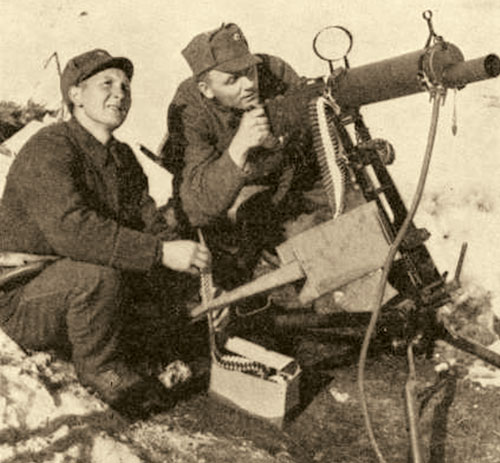
|
The exception to this were the Norwegian 6th Division forces in the
vicinity of Narvik. The outcome of the Winter War between Finland and
the Soviet Union had resulted in Soviet forces being in the vicinity.
The Norwegians had forces on neutrality watch in the northern part of
the country. These forces were well equipped – in Norwegian terms.
The Norwegians chose to fight. Several factors
weighed in this decision. Firstly, the sinking of the Blücher by the
28cm guns at Oscarsborg delayed the German advance on Oslo, thus giving
the government time to assess and respond to the situation. Secondly,
the Allied forces were quick in promising help – forces were already
committed even before the German attack.
|
Finally the king threatened to
abdicate if the politicians choose an immediate surrender. Consequently
the royal family, the government, and the country’s gold reserves were
moved out of Oslo, setting up field camp further north. Mobilisation
began, and the Norwegians took up the fight. The mountainous terrain and
the size of the country favoured the defence, which was kept up for a
considerable time.
Allied Plans and Forces
For the Allies, the
occupation of Norway made strategic sense. The concerns of the British
and French governments focused mainly on the port of Narvik, from which
Swedish high grade iron ore was shipped to Germany. Secondly ‘the Leads’
is the deep waterway between the archipelago and the mainland of
Norway, where German ships under protection of Norwegian neutrality
could not only maintain trade connections with Norway, but also slip into the Atlantic.
|
The
first plan for the Allies to get troops into Norway without losing
popular and political support in Scandinavia was to field them as help
for Finland after the Russian attack on 30 November 1939. The Finnish
surrender on 12 March 1940, thwarted this plan. Therefore a new plan was
set up, where ‘the Leads’ would be mined, with or without Norwegian
consent. In expectation of a German response, troops would be embarked
and ready for landing into the main Norwegian cities.
According to the plan they were to begin landing operations at the
moment when ‘the Germans set foot on Norwegian soil, or there is clear
evidence that they intend to do so’. The Germans set foot on Norwegian
soil sooner than the British expected. The mining operations were set to
happen on 8 April, by coincident coinciding with the time when German
ships also left their ports to move on Norway. Not expecting a respond
quite so soon, the Allied forces were taken by surprise and the campaign
became a confused and badly conducted affair from which the Allied
forces were withdrawn in June.
|
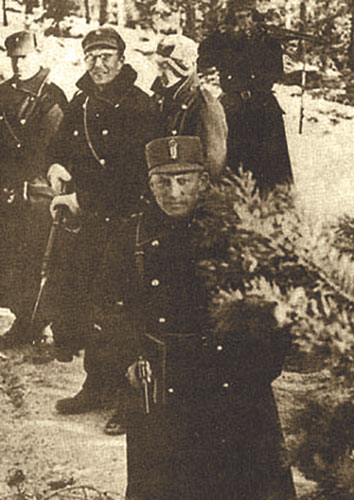 |
The remarkable British ineptness in military logistics, planning and coordination during the early years of the war also plagued the Norwegian Campaign. There was no theatre commander, the campaign being run by a bewildering series of political committees, and the forces of the three arms were not put under any central military control. This seriously reduced the effectiveness of the fighting, and not much was accomplished. Being much the brainchild of Winston Churchill, the ensuing political debate forced Neville Chamberlain to resign his office as prime minister, paradoxically being succeeded by Churchill.
The Campaign
The conduct of the German attack itself was exemplary—insofar as an unprovoked attack on a neutral country can bear that description. Weserübung Nord was a complicated military operation involving coordinated action between forces of all three arms. The various branches of the armed forces seemed to have worked well together, and although the terrain was difficult, the attack eventually succeeded. There were of course set-backs, the sinking of the cruiser Blücher enroute to Oslo being one of the most serious, along with the loss of other important naval assets. Bad weather made air landings difficult or impossible, but in general this was another demonstration of the superiority of the German
Wehrmacht during the early years of World War II. The German landings began on 9 April 1940.
|
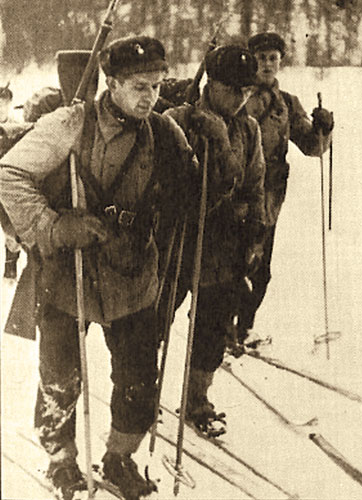
|
The German Initial Landings
The first Fallschirmjäger airdrops:
SOLA: One of the main German objectives was to capture usable airfields in Norway to support the German troops after their initial landings. Sola was an airfield just outside the town of Stavanger. Supported by Me-110 aircraft, the 3rd Company of 1. Fallschirmjäger-Regiment jumped onto the airfield. Ten minutes after their jump started, Ju-52s were landing and disembarking German reinforcements from 193. Infanterie-Regiment.
FORNEBU: Fornebu was an airfield just outside Oslo. This not quite completed airstrip was important to German plansm as well. Due to bad weather and heavy fog, the first wave of Fallschirmjäger aborted their planned airdrop on the airfield. The follow on forces decided to continue and landed their Ju-52s on the sparsely defended airstrip, capturing it in a short time.
|
Seaborne Assaults
BERGEN: After He-111 bombers bombed the port’s
forts, the German 159. Infanterie-Regiment of 69. Infanteriedivision
were able to swiftly capture the town. The Norwegian 9th Infantry
Regiment withdrew to the interior of Norway as the landing commenced.
Further east, the 10th Norwegian Infantry Regiment at Voss was able to
mobilize unmolested. These Norwegian forces were part of the 6th
Division.
KRISTIANSAND: The German 310. Infanterie-Regiment landed and swiftly
captured the town. They make simultaneous landings at Arendal and
Egersand, capturing those town’s vital cable stations. The Norwegian 7th
Infantry Regiment along with one battalion of the 3rd Regiment withdrew
into the interior.
STAVANGER: 193. Infanterie-Regiment of 69.
Infanteriedivision was responsible for securing Stavanger. The town fell
on the same day as the airport at Sola. The Norwegian 8th Infantry
Regiment along with one battalion of the 2nd Regiment withdrew inland.
TRONDHEIM:
The city was nominally defended by the Norwegian 5th Division. However,
when the three battalions of 138. Gebirgsjäger-Regiment landed, they
encountered no resistance in the city. The Norwegian forces had
withdrawn to Steinkjer, joining the 13th Infantry Regiment, and the city
was secured by the Germans by nightfall.
OSLO: Difficulties in
the initial seaborne assault resulted in a delay securing the city until
the following day (10 April). However, the airfield at Fornebu did fall
on the 9 April.
NARVIK: A confused situation and the threat of
Narvik being destroyed by naval bombardment resulted in the surrender of
part of the town garrison. Other Norwegian forces slipped out of town
to fight to continue the fight. The town was occupied by the Germans of
139. Gebirgsjäger-Regiment of 3. Gebirgsdivision before nightfall. |
Battle for the Ostfold
The Germans in Oslo first objective was to advance and make contact with the forces that had landed in Trondheim. However, the German High Command was soon aware that a large number of Norwegian troops were gathering south-east of Oslo in the Askim-Mysen area. These troops could not be left alone. The German 169. Infanteriedivision was given the task of eliminating these Norwegian forces.
The Germans began their advance on the morning of 12 April, reaching the Glama River outside Askim just before noon. The fighting along the river continued for the rest of the day. Two German attempts to cross at bridges north and south of Askim were repulsed by Norwegian forces.
|
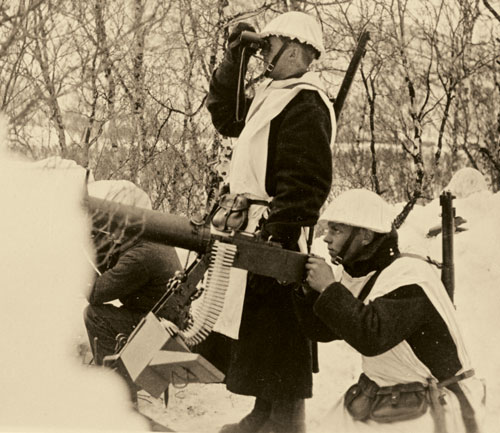
|
The Germans launched an attack once night fell and they were able to
establish a bridgehead over the river. A Norwegian counterattack failed
to oust the Germans, thus the Germans were across to stay.
The
fighting resumed on 13 April. Local counterattacks by the Norwegians
couldn’t change the situation, and they fell back to Askim town.
Norwegian artillery support helped hold the Germans back, but by noon
the situation had become critical.
The Germans were outflanking the Norwegian positions and by 3.30pm Askim falls, followed by Mysen around
10pm. The retreating Norwegian forces choose to withdraw into Sweden, where they are interned, rather than fall into German hands.
|
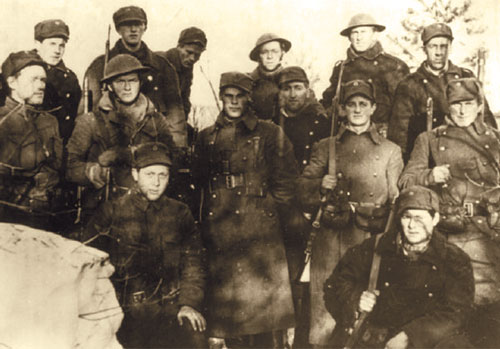
|
The Germans Drive North From Oslo
On 12 April the German 196. Infanteriedivision and 163. Infanteriedivision began their drive north to link up with the forces at Trondheim. 163. Infanteriedivision captured Honefoss, an important garrison for the Norwegian 6th Infantry Regiment, on 14 April. However, the German 24. Infanterie-Regiment was held north of the town by determined Norwegian troops at a roadblock south of Stryken.
The German 362. Infanterie-Regiment continued to advance, until they were held on 16 April at Strandlokka. 163. Infanteriedivision reached Bagn on 19 April, but strong defensive fighting by Norwegian forces deny them the town that night.
|
On 20 April the German 345. Infanterie-Regiment attacked forces of the
Norwegian 5th Infantry Regiment and 2nd Dragoon Regiment, south of
Lillehammer at Lundehogda. British troops of the Sherwood Forester
Regiment took up positions with Norwegians at Brastad.
The following day (21 April), the British Royal Leicestershire Brigade held at Asmarka, allowing the Norwegians to withdraw to Lillehammer. The withdrawal went smoothly, but the rearguard troops were overrun by German armoured cars. To the east, Rena-Amot fell after bitter fighting.
Advancing south from Trondheim, on 22 April, German forces captured the bridges at Nypan and Melhos. At the same time, German forces advancing north from Lillehammer bypassed the Norwegian defences at Balberkamp, forcing the Allies there into a hasty retreat. The Allies reformed a new line at Tretten. German Gebirgsjäger troops bypass the Allied defensive lines, threatening the flank.
British 148th Brigade (Territorial) joined
the Allied force retreating to Tretten. On 23 April, along with
retreating Norwegian troops, they tried to halt the Germans at Tretten.
Using Boys anti-tank rifles the British attempted to knock out the
armoured cars, but the fight there ended quickly, as the German mountain
troops once again outflanked the position.
|
The Allied forces made one last desperate attempt to hold the Germans at Kvam. The British 15th Brigade, augmented with French 25mm Hotchkiss anti-tank guns, put up stiff resistance against the advancing German Group Pellengahr (196. Infanteriedivision with supporting forces.) The anti-tank guns were able to deal with the German armoured support, but, once again, mountain troops outflanked the defensive position, forcing a withdrawal.
|
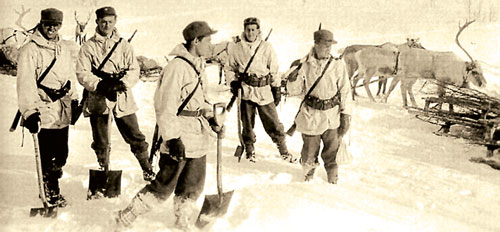
|
On 30 April, German forces from Oslo make contact
with troops moving south from Trondheim. Their linkup had been made
easier by the decision of the British on 27 April to abandon central
Norway, returning all British forces in that area of the country to
England. On the same day that the Germans linked up, the British forces
that landed at Andalsnes re-embark on ships in the port and head for
home.
The Battle of Narvik
After consolidating his hold on Narvik, the German 3. Gebirgsdivision Commander Eduard Dietl prepared to
widen his area of control. The following morning (10 April) the Germans drove north, but were stopped by Norwegian troops north of Bjerkvik, on the road to Bardufoss.
The Germans had lost all of their destroyers that had brought troops and supplies in the naval battle of Ofotfjord outside Narvik. With the British in control of the waters, the Germans were essentially cut off from all re-supply. On 13 April, four 7.5cm mountain howitzers were delivered to the Germans by airlift. To make matters worse for the Germans, the British landed reinforcements to aid the Norwegians on 14 April at Harstad.
On 23 April, the Norwegian 6th Brigade started operations to reduce the
German perimeter. The following day, the 12th Norwegian Infantry
Regiment attacked the town of Gratangen. A fierce German counterattack
denied the town to the Norwegians, but the German position there proved
untenable. The Germans withdrew the next day and the town fell to the
Norwegians.
|
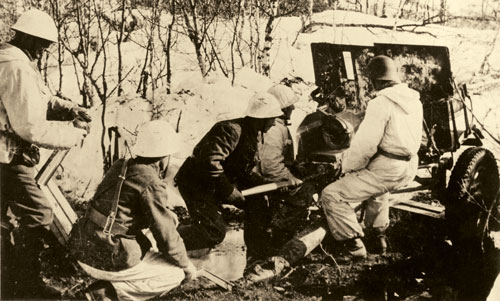 |
The following day, three battalions of French Chasseur Alpins (mountain troops) arrive at Hinnoy Island, which was the staging area for Allied forces in the Narvik region. It was also the headquarters of the Norwegian 6th Division area. The Allies send further reinforcements to Narvik. The British 2nd South Wales Infantry landed at Ballagen on 27 April. On 28 and 29 April further British and French reinforcements landed at Hakvik and attacked Ankenes, which was held by a single company of German Gebirgsjäger.
|
As the situation for Dietl and his mountain troops got more desperate,
the Germans ordered 2. Gebirgsdivision, located outside Trondheim, to
move north to assist Dietl and his 3. Gebirgsdivision. 2.
Gebirgsdivision had reached Grong by 5 May.
The Norwegians continued to compress the German perimeter at Narvik, liberating Leigstind and Roasme on 8 May. They made further gains by 10 May, when they advanced from Elvenes and reach Bjerkvik.
To the south, British and Norwegian (14th Infantry Regiment) forces located south of Mosjoen briefly resisted the advancing 2. Gebirgsdivision as it drove north. 2. Gebirgsdivision captured Mosjoen on 11 May.
Additional French reinforcements, including H-39 light tanks, landed at Bjerkvik on 13 May, with the Norwegians at Elvenes linking up with them the following day.
The advance of 2. Gebirgsdivision from the south continued with the capture Elsfjorden on the 15 May. At Mo, on 17 May, the advancing 2. Gebirgsdivision was met with stiff resistance by the Scots Guards and the Germans were not able to occupy the town until late on 18 May.
|
For the first time during the Norwegian Campaign, the Allies received adequate air support in the Narvik area from two squadrons of aircraft stationed at Bardufoss. The British 264th Squadron, flying Gloster Gladiators arrived on 21 May. They held off the worst of the Luftwaffe ground attacks at bay.
The first troop reinforcements arrived for the German 3. Gebirgsdivision when paratroopers were dropped between 22 and 25 May to reinforce Dietl’s forces. From the south, 2. Gebirgsdivision continued its advance northward, taking Pothus on 26 May.
|
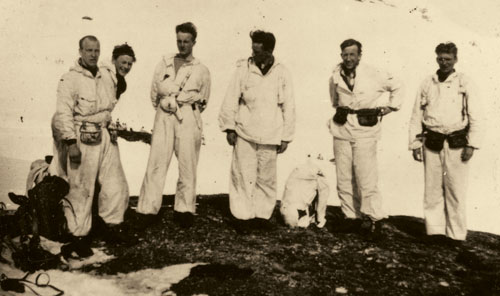
|
The Allied pressure in the Narvik area became too much for the German
defenders, and on 28 May they evacuated Narvik and withdrew into the
mountain areas to the north and east of the port. On the same day,
British Hurricane Fighters (46th Squadron) arrived to reinforce the
Gladiators at Bardufoss.
On 31 May, British and French Forces in the area withdrew to Bodo and began to evacuate Norway. Despite this, the Norwegians continued to drive in the perimeter of the Germans defences in the mountains north and east of Narvik. Allied withdrawal allowed the easy advance of 2. Gebirgsdivision, which entered Bodo on 1 June and reached Sorfold on 2 June.
The withdrawal of the British and French forces spelled the end of the Norway campaign. The German 3. Gebirgsdivision re-occupied Narvik on 9 June and the Norwegians capitulate the following day.
Total military casualties, including the naval battles, were 5296 Germans; 3368 British; 533 French; and 1700 Norwegians. The operation was a decisivie success for Germany, but the Kriegsmarine suffered crippling losses making any attempts to invade Britain unlikely.
|
 |
The Norwegians 1940 In Flames Of War
The Norwegians 1940 Intelligence Briefing contains the following:
■ History of the attack on Norway and the Allied intervention.
■ Norwegian Special Rules.
■ Gevärskompani (Rifle Company).
■ Dragoneskadron (Dragoon Cavalry Squadron).
■ Norwegian Divisional Support.
■ French Support.
■ British Support.
■ Norwegian Arsenal.
■ Norwegian Modelling & Painting Guide.
Download a PDF version of the Norwegians 1940 Intelligence Briefing here... |
Last Updated On Tuesday, March 11, 2014 by Blake at Battlefront
|
|
|